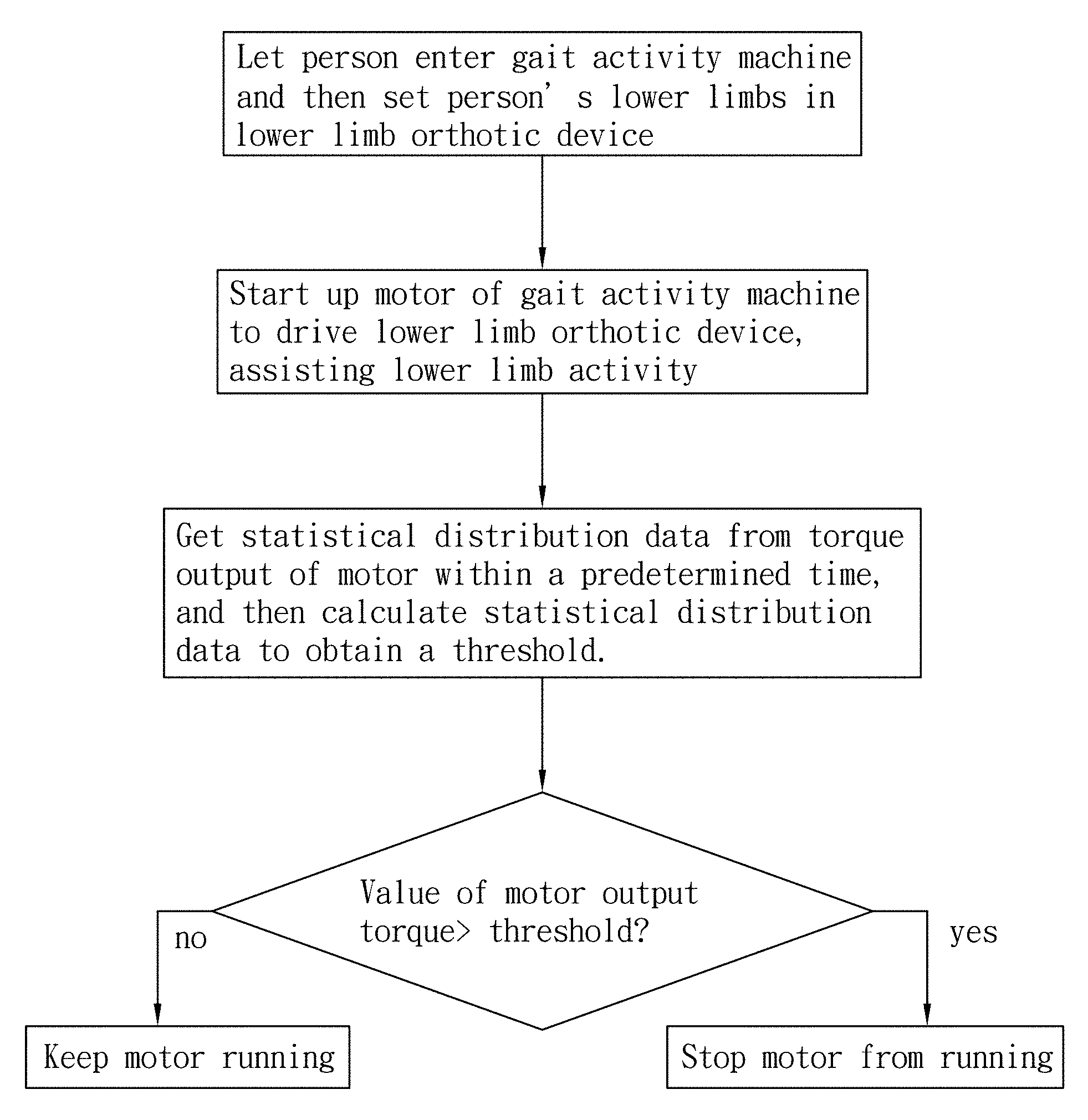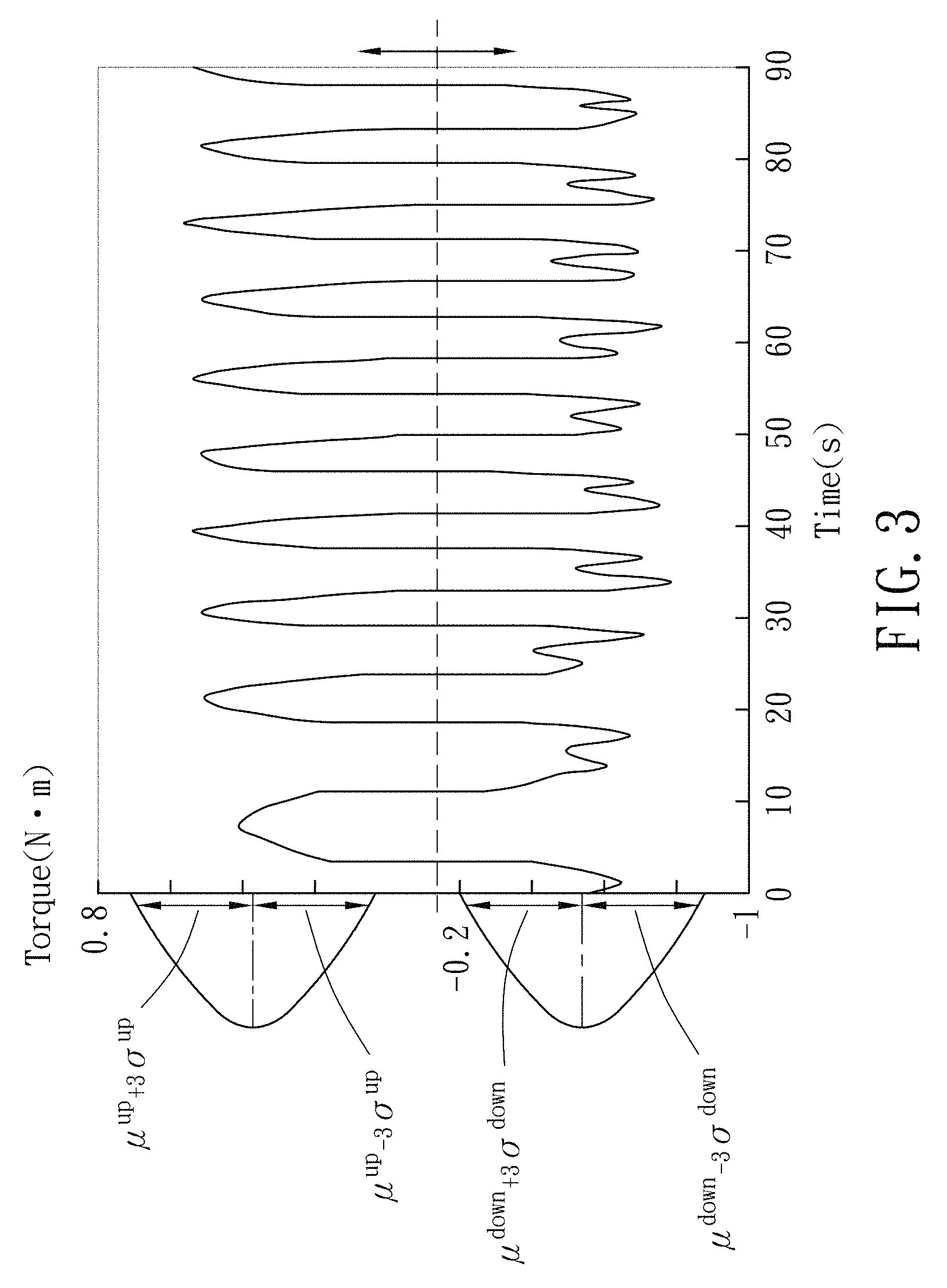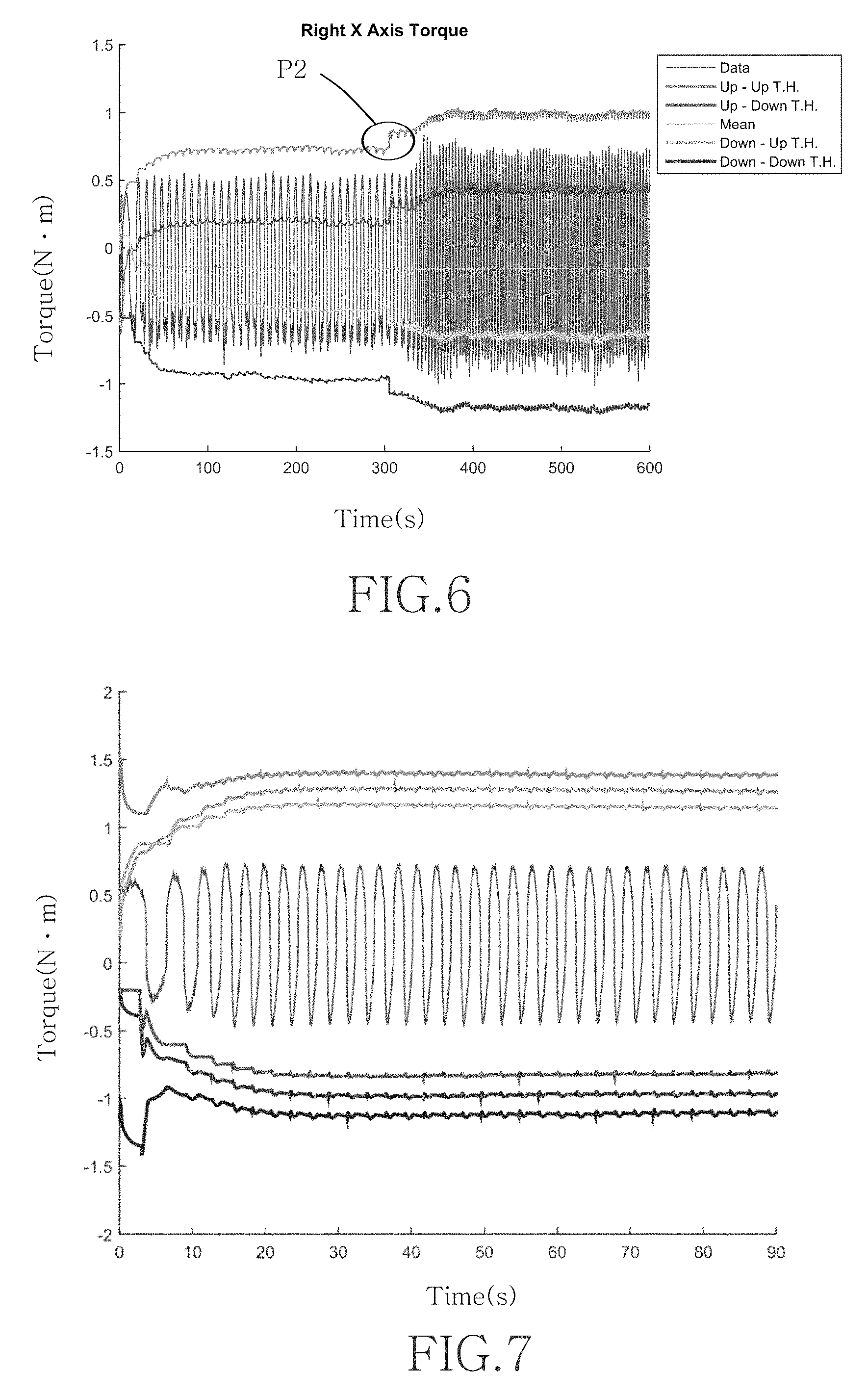Lower limb spasticity measurement method
Hou , et al. No
U.S. patent number 10,463,308 [Application Number 15/167,511] was granted by the patent office on 2019-11-05 for lower limb spasticity measurement method. This patent grant is currently assigned to Hiwin Technologies Corp.. The grantee listed for this patent is HIWIN TECHNOLOGIES CORP.. Invention is credited to Jung-Fu Hou, Yu-Chia Liang, Chang-Jin Yu.






| United States Patent | 10,463,308 |
| Hou , et al. | November 5, 2019 |
Lower limb spasticity measurement method
Abstract
A lower limb spasticity measurement method includes the step of setting the lower limbs of the person in a lower limb orthotic device of a gait activity machine, the step of starting up a motor of the gait activity machine to drive the lower limb orthotic device for lower limb activity, the step of getting a statistical distribution data from the output torque of the motor within a predetermined time and then calculating the statistical distribution data to obtain a threshold, and the step of determining whether the output torque of the motor is greater than the threshold or not, and then stopping motor if the output torque of the motor is greater than the threshold. Thus, the method of the invention can accurately measures spasticity in the lower limbs of a person without the use of sensors, effectively saving the cost of equipment.
| Inventors: | Hou; Jung-Fu (Taichung, TW), Liang; Yu-Chia (Taichung, TW), Yu; Chang-Jin (Taichung, TW) | ||||||||||
|---|---|---|---|---|---|---|---|---|---|---|---|
| Applicant: |
|
||||||||||
| Assignee: | Hiwin Technologies Corp.
(Taichung, TW) |
||||||||||
| Family ID: | 69061023 | ||||||||||
| Appl. No.: | 15/167,511 | ||||||||||
| Filed: | May 27, 2016 |
Prior Publication Data
| Document Identifier | Publication Date | |
|---|---|---|
| US 20170340286 A1 | Nov 30, 2017 | |
| Current U.S. Class: | 1/1 |
| Current CPC Class: | A61B 5/4519 (20130101); A61B 5/702 (20130101); A61B 5/1107 (20130101); A61B 5/1124 (20130101); A61B 5/7225 (20130101); A61B 5/112 (20130101); A61B 5/11 (20130101); A61B 5/6812 (20130101) |
| Current International Class: | A61B 5/11 (20060101); A61B 5/00 (20060101) |
| Field of Search: | ;601/5 ;600/587,595 |
References Cited [Referenced By]
U.S. Patent Documents
| 5052406 | October 1991 | Nashner |
| 6589190 | July 2003 | Kanderian, Jr. |
| 6666831 | December 2003 | Edgerton |
| 7163492 | January 2007 | Sotiriades |
| 8308618 | November 2012 | Bayerlein |
| 8460162 | June 2013 | Park |
| 8771208 | July 2014 | Agrawal |
| 8920347 | December 2014 | Bayerlein |
| 9314393 | April 2016 | Kim |
| 9555276 | January 2017 | Kim |
| 9616282 | April 2017 | Tholkes |
| 9750978 | September 2017 | Nakashima |
| 9895282 | February 2018 | Butters |
| 2008/0312549 | December 2008 | Levin |
| 2014/0343459 | November 2014 | Chino |
| 2015/0374278 | December 2015 | Hsieh |
| 2017/0157396 | June 2017 | Dixon |
| 2017/0311848 | November 2017 | Wu |
| 508091 | Oct 2010 | AT | |||
Other References
|
Banala, et al. "A powered leg orthosis for gait rehabilitation of motor-impaired patients." Robotics and Automation, 2007 IEEE International Conference on. IEEE, 2007. cited by examiner . MyMedicNews, "Hiwin . . . the Robotic Gait Training System" Video published Sep. 9, 2014. Retrieved from <http://mymedicnews.com/video/756-hiwin-heralds-robotic-age-for-occupa- tional-therapy-and-post-injury-motor-function-recove> on Jun. 22, 2018. cited by examiner . Schmidt, Henning, et al. "Gait rehabilitation machines based on programmable footplates." Journal of neuroengineering and rehabilitation 4.1 (2007): 2. cited by examiner . TaiwanTrade.com "Hiwin robotic rehabilitation system to gain China market approval" Mar. 20, 2015. Retrieved from <https://www.taiwantrade.com/news/hiwin-robotic-rehabilitation-system-- to-gain-china-market-approval-49247.html#> on Jun. 22, 2018. cited by examiner . Woodway. "LokoHelp the Way to Walk" May 5, 2015. Retrieved from <https://web.archive.org/web/20150505205651/http://www.woodway.com/pro- ducts/lokohelp 1/> on Jun. 22, 2018. cited by examiner . Banala, et al. "Active Leg Exoskeleton (ALEX) for gait rehabilitation of motor-impaired patients." Rehabilitation Robotics, 2007. ICORR 2007. IEEE 10th International Conference on. IEEE, 2007. cited by examiner . MedGagdet.com "Touring Taiwan's Medtech Sector: Hiwin Enters Medical Space" May 11, 2015. Retrieved from <https://www.medgadget.com/2015/05/touring-taiwans-medtech-sector-hiwi- n-enters-medical-space.html> on Jun. 22, 2018. cited by examiner . buyKorea.com "Walkbot Robot--assisted gait training system" Oct. 21, 2014. Retrieved from <http://www.buykorea.org/product-details/walkbot-robot-assisted-gait-t- raining-system--3007930.html> Jun. 22, 2018. cited by examiner. |
Primary Examiner: McCrosky; David J.
Attorney, Agent or Firm: Muncy, Geissler, Olds & Lowe, P.C.
Claims
What is claimed is:
1. A lower limb spasticity measurement method without a sensor, comprising the steps: a) letting a person enter a gait activity machine, and then setting the lower limbs of said person in a lower limb orthotic device of said gait activity machine; b) starting up a motor of said gait activity machine to drive said lower limb orthotic device for the activity of the lower limbs of said person; c) getting a statistical distribution data from an output of a torque variation of said motor within a predetermined time, and then calculating said statistical distribution data to obtain a threshold; and d) spasticity is determined if the output torque is greater than the threshold, stopping said motor if the output torque of said motor is greater than said threshold; wherein the statistical distribution data comprises a positive half cycle interval and a negative half cycle interval, the threshold for the positive half cycle intervals and the threshold for the negative half cycle intervals are defined as: TH.sup.up=.mu..sup.up.+-.3.sigma..sup.up TH.sup.down=.mu..sup.down.+-.3.sigma..sup.down wherein TH.sup.up is the threshold of the positive half cycle interval; .mu..sup.up is a mean value of the positive half cycle interval; .sigma..sup.up is a standard deviation of the positive half cycle interval; TH.sup.down is the threshold of the negative half cycle interval; .mu..sup.down is a mean value of the negative half cycle interval; .sigma..sup.down is a standard deviation of the negative half cycle interval.
2. The lower limb spasticity measurement method as claimed in claim 1, wherein the threshold for said positive half cycle interval and the threshold for said negative half cycle interval are further defined as TH.sup.up=.mu..sup.up.+-.3.sigma..sup.up+Sv and TH.sup.down-.mu..sup.down.+-.3.sigma..sup.down Sv respectively, in which Sv is a correction parameter that is obtained by calculating the operating speed of said motor and the stride length of said person using surface fitting technique.
3. The lower limb spasticity measurement method as claimed in claim 2, wherein the threshold for said positive half cycle interval and the threshold for said negative half cycle interval are further defined as TH.sup.up=.mu..sup.up.+-.3.sigma..sup.up+Sv+S.omega..sup.up and TH.sup.down=.mu..sup.down.+-.3.sigma..sup.down SV+S.omega..sup.down respectively, in which S.omega..sup.up and S.omega..sup.down are the sensitivity parameter for the gait activity machine in spasticity measurement.
4. The lower limb spasticity measurement method as claimed in claim 3, wherein said sensitivity parameter satisfies the equation of S.omega..sup.up=(.mu..sup.up-.mu..sup.data)*.omega. and the equation of S.omega..sup.down=(.mu..sup.data-.mu..sup.down)*.omega., in which .mu..sup.data is the overall mean value of the statistical distribution data; .omega. is the weight in the range from the most sensitive 0 to the least sensitive 1.
Description
BACKGROUND OF THE INVENTION
1. Field of the Invention
The present invention relates to lower limb activity technologies and more particularly, to a lower limb spasticity measurement method for measuring the spasticity of the lower limbs.
2. Description of the Related Art
For the person with paraplegia caused by spinal cord injury, stroke, nerve damage and other causes . . . , their body positioning, joint movement and other daily activities need to rely on medical aids, further, the implementation of activity works should also be carried out subject to the assistance of related auxiliary devices. However, during the implementation of a activity work, cramps in the lower body of the person can occur due to muscle fatigue or other factors. At this time, the activity work must be stopped, and the activity work can be started again only after the person has enough rest.
US Patent Number 2014/0343459 discloses a spasticity measurement apparatus, which uses a strain gauge and a potentiometer to measure a muscular contraction force for easily evaluating spasticity of the lower limbs. Further, US Patent Number 2008/0312549 teaches a method for quantitative measurement of spasticity in a person by measuring a joint angle and EMG activity in the limb, determining a threshold EMG activity value and a zero angle, recording angle and velocity as a data point at which the measured EMG value crosses the threshold EMG activity value. However, the aforesaid two prior art patents require the use of sensor means to achieve the expected effect, leading to the problem of expensive equipment.
SUMMARY OF THE INVENTION
The present invention has been accomplished under the circumstances in view. It is the main object of the present invention to provide a lower limb spasticity measurement method for measurement of spasticity in the lower limbs of a person, which directly fetches motor torque signal for measurement of spasticity without the use of additional sensors, thereby effectively saving equipment cost.
To achieve this and other objects of the present invention, a lower limb spasticity measurement method comprises a first step of letting a person enter a gait activity machine and then setting the lower limbs of the person in a lower limb orthotic device of the gait activity machine, a second step of starting up a motor of the gait activity machine to drive the lower limb orthotic device in assisting activity of the lower limbs of the person, a third step of getting a statistical distribution data from the torque output of the motor within a predetermined time and then calculating the statistical distribution data to obtain a threshold, and a fourth step, namely, the last step of determining whether the output torque of the motor is greater than the threshold or not. If the output torque is greater than the threshold, it means that the person gets spasticity. At this time, stop the motor immediately. If the output torque is not greater than the threshold, it means the condition of the person is normal. At this time, let the motor keep running.
Further, the statistical distribution data is divided into a positive half cycle interval and a negative half cycle interval. The threshold for the positive half cycle interval and the threshold for the negative half cycle interval are defined as TH.sup.up=.mu..sup.up.+-.3.sigma..sup.up and TH.sup.down=.mu..sup.down.+-.3.sigma..sup.down respectively, in which TH.sup.up is the threshold of the positive half cycle interval; .mu..sup.up is the mean value of the positive half cycle interval; .sigma..sup.up is the standard deviation of the positive half cycle interval; TH.sup.down is the threshold of the negative half cycle interval; .mu..sup.down is the mean value of the negative half cycle interval; .sigma..sup.down is the standard deviation of the negative half cycle interval.
Further, in lines with the needs of different people, the aforesaid two equations can be modified subject to the operating speed of the motor, the stride length of the person and the sensitivity of the gait activity machine to
Other advantages and features of the present invention will be fully understood by reference to the following specification in conjunction with the accompanying drawings, in which like reference signs denote like components of structure.
BRIEF DESCRIPTION OF THE DRAWINGS
FIG. 1 is a flow chart of a lower limb spasticity measurement method in accordance with the present invention.
FIG. 2 is a schematic structural view of a gait activity machine used in accordance with the present invention.
FIG. 3 is a scatter plot of motor torque versus time graph coordinates.
FIG. 4 is similar to FIG. 3, illustrating spasticity occurred in the lower limbs of the person.
FIG. 5 is a plot illustrating the surface correction of the correction parameter.
FIG. 6 is a scatter plot of motor torque versus time graph coordinates obtained after added correction parameter to the threshold.
FIG. 7 is a scatter plot of motor torque versus time graph coordinates obtained after added sensitivity parameter to the threshold.
DETAILED DESCRIPTION OF THE INVENTION
Referring to FIG. 1, a lower limb spasticity measurement method in accordance with the present invention comprises the steps as follows: a) Let a person enter a gait activity machine 10, as illustrated in FIG. 2, and then set the lower limbs of the person in a lower limb orthotic device 12. b) Start up a motor 14 of the gait activity machine 10 to drive the lower limb orthotic device 12, assisting activity of the lower limbs of the person. c) Get a statistical distribution data from the output of the torque variation of the motor 14 within a predetermined time, and then calculate the statistical distribution data to obtain a threshold.
As illustrated in FIG. 3, the statistical distribution data is divided into a positive half cycle interval and a negative half cycle interval. The projection of the positive half cycle interval and the projection of the negative half cycle interval on y-axis respectively form a normal distribution. A normal signal will fall within this normal distribution. Thereafter, use the concept of confidence interval to determine the data of one particular measurement point to be or not to be a normal signal. If the data of this particular measurement point is a normal signal, the data of this particular measurement point will fall within the range of the mean value of the positive, negative half cycle interval plus or minus three standard deviations. Therefore, in this step c), calculate the mean value and standard deviation of the positive and negative half cycle intervals, and then define the threshold for the positive and negative half cycle intervals using the concept of confidence interval, and thus, the following two equations are obtained: TH.sup.up=.mu..sup.up.+-.3.sigma..sup.up TH.sup.down=.mu..sup.down.+-.3.sigma..sup.down in which TH.sup.up is the threshold of the positive half cycle interval; .mu..sup.up is the mean value of the positive half cycle interval; .sigma..sup.up is the standard deviation of the positive half cycle interval; TH.sup.down is the threshold of the negative half cycle interval; .mu..sup.down is the mean value of the negative half cycle interval; .sigma..sup.down is the standard deviation of the negative half cycle interval. d) Determine whether or not the output torque of the motor 14 is greater than the threshold? If the output torque is greater than the threshold, as indicated by P1 in FIG. 4, it means that the person gets spasticity. At this time, stop the motor 14 immediately. If the output torque is not greater than the threshold, it means the condition of the person is normal. At this time, let the motor 14 keep running.
On the other hand, since stride length varies widely from patient to patient and the operating speed of the motor 14 may also be differently set for different people, the present invention utilizes surface fitting technique to calculate the operating speed of the motor 14 and the stride length of the person so as to obtain a correction parameter (see FIG. 5). Thus, the threshold of the positive half cycle interval is corrected to become TH.sup.up=.mu..sup.up.+-.3.sigma..sup.up+Sv for the positive half cycle interval and TH.sup.down=.mu..sup.down.+-.3.sigma..sup.down-Sv for the negative half cycle interval, in which Sv is the correction parameter. Therefore, it can be seen from P2 in FIG. 6, it is assumed to change the operating speed of the motor 14 in the first 300 seconds, the threshold will be automatically corrected without needing recalibration.
Further, a sensitivity parameter can be added to the equation, enabling the threshold to be further corrected to become TH.sup.up=.mu..sup.up.+-.3.sigma..sup.up+Sv+S.omega..sup.up for the positive half cycle interval and TH.sup.down=.mu..sup.down.+-.3.sigma..sup.down-Sv+S.omega..sup.down for the negative half cycle interval, in which S.omega..sup.up and S.omega..sup.down are the sensitivity parameter for the gait activity machine in spasticity measurement. This sensitivity parameter satisfies the following equations: S.omega..sup.up=(.mu..sup.up-.mu..sup.data)*.omega. S.omega..sup.down=(.mu..sup.data-.mu..sup.down)*.omega. in which .mu..sup.data is the overall mean value of the statistical distribution data; .omega. is the weight in the range from the most sensitive 0 to the least sensitive 1. With this sensitivity parameter, it allows adjustment of the range of the threshold according to the condition of the person, as illustrated in FIG. 7, thus achieving the effect of changing the sensitivity of the measurement.
In conclusion, the lower limb spasticity measurement method of the invention utilizes the output torque of the motor 14 as signal source for measuring spasticity in the lower limbs of a person during activity without the use of additional sensors. Thus, the method of the invention effectively saves the cost of equipment. Further, during activity, the person can adjust the speed without re-calibration, and can also adjust the sensitivity of the measurement according to the person's personal needs, thereby enhancing the ease of use.
* * * * *
References
-
mymedicnews.com/video/756-hiwin-heralds-robotic-age-for-occupational-therapy-and-post-injury-motor-function-recove
-
taiwantrade.com/news/hiwin-robotic-rehabilitation-system-to-gain-china-market-approval-49247.html
-
woodway.com/products/lokohelp1
-
medgadget.com/2015/05/touring-taiwans-medtech-sector-hiwin-enters-medical-space.html
-
buykorea.org/product-details/walkbot-robot-assisted-gait-training-system--3007930.html
D00000

D00001

D00002

D00003

D00004

D00005

XML
uspto.report is an independent third-party trademark research tool that is not affiliated, endorsed, or sponsored by the United States Patent and Trademark Office (USPTO) or any other governmental organization. The information provided by uspto.report is based on publicly available data at the time of writing and is intended for informational purposes only.
While we strive to provide accurate and up-to-date information, we do not guarantee the accuracy, completeness, reliability, or suitability of the information displayed on this site. The use of this site is at your own risk. Any reliance you place on such information is therefore strictly at your own risk.
All official trademark data, including owner information, should be verified by visiting the official USPTO website at www.uspto.gov. This site is not intended to replace professional legal advice and should not be used as a substitute for consulting with a legal professional who is knowledgeable about trademark law.